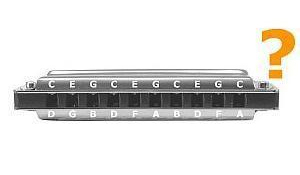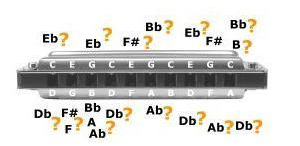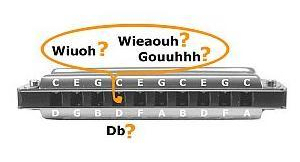Bending
Why are there missing notes on a Diatonic Harmonica?

The note layout of a Diatonic Richter Harmonica is a mix out of chords and melody. It was invented by Joseph Richter in 1875 already.
The lowest three holes are intended to play accompaniment. Therefore only notes from the chord are present - others would cause a dissonant sound. For playing melodies all the eight notes from of the major scale are placed in holes 4 to 7.
For the folky music that was played those days the possibility to play chord accompaniment chord and melody at once was absolutely unique on an instrument of this size.
However for playing more elaborated melodies you will need chromatic notes missing on the harmonica - no matter if you play Classics, Pop, Rock or Jazz - the usual 20 notes available on a diatonic are not enough!
Which notes are missing on a harmonica tuned to Richter tuning?

The following table shows the missing blow and draw notes for a Blues Harmonica in the key C.
|
Missing notes - blow
|
Eb1 | Eb2 | f#2 | Bb2 | ||||||
|
|
|
|
|
|
|
|
|
|
Bb3 | |
| Eb3 | f#3 | B3 | ||||||||
|
Blow
|
c1 | e1 | g1 | c2 | e2 | g2 | c3 | e3 | g3 | c4 |
|
hole
|
1 | 2 | 3 | 4 | 5 | 6 | 7 | 8 | 9 | 10 |
|
Draw
|
d1 | g1 | b1 | d2 | f2 | a2 | b2 | d3 | f3 | a3 |
|
Missing notes - draw
|
Db1 | f#1 | Bb1 | Db2 | Ab2 | |||||
| f1 | a1 | |||||||||
| Ab1 | ||||||||||
| Db3 | Ab3 | Db4 |
The following example shows how you can overcome the problem of some of the missing notes:
Think of playing some Blues. For playing typical Blues licks in second position (playing in the key of G on a diatonic in C) you build up your improvisation on the basis of the notes of the Blues Scale:
G - Bb - C - Db - D - F - G
The Bb in hole 3 and the Db in hole 4 are not available as usual draw or blow notes.
Naturally available notes are displayed in light grey - dark grey notes are the so called bending notes where you need to apply a special playing technique. "Missing notes" of the blow side are called 'Blow bendings', those of the draw side are the so called 'Draw bendings' .
The notes indicated in yellow are so called overblows - can only be played by another even more advanced playing technique, the so called 'Overblowing' (search for "harmonica & overblow" on YouTube for more information).
Bending

As a first approach into bending notes, try to play the missing note Db in hole 4 draw of a diatonic harmonica in the key of C.
Please be aware of the fact that you need to be able to play an individual note on the harmonica by the so called 'Lipping' or 'Puckering' technique as shown on our >Instructional Sheet for Diatonic Harmonicas.
In the following example you will first hear the natural note D, then the Bend in Db, and then again the natural note D.
small:Bending in 4 draw
The bent note which is lowered by a semi-tone is played while drawing or inhaling: try to press the back part of your tongue slightly
upwards (more inside the mouth) - at the same time try to narrow the throat space. You can first silently speak the syllables from the picture above while drawing breathing in (wheouu). If you do so you will get an impression of how the movement of throat and tongue effects the sound.
Please don't give up too early! Everyone has a different mouth shape and pharynx lenght, so there are no fixed rules of how to exactly works fo you - don't give up it is very much worth the efforts!
After a while the sound of the bent notes will improve and you can use them as an additon for you music. Bent notes only can generate the typical bluesy sound of a diatonic Blues harmonica solo!







